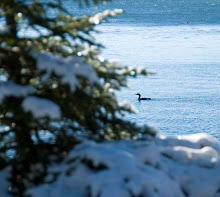Even though we're deep in the dead of winter these days, ice can still be tricky $ as a couple of visitors found out last weekend.
Dennis Belmonte, of Middleton, Mass., was riding with a group of three other snowmobilers on Sunday when his sled crashed through thin ice near North Twin Dam not far from Millinocket. It was the same area where a man from Connecticut was killed last spring when snowmobiling onto thin ice.
As a result, the Maine Warden Service for the second time this season is issuing a reminder to outdoorsmen to use extreme caution when going onto ice, "particularly in areas near bridges, thoroughfares, culverts and wherever else there may be currents flowing underneath as ice in these areas may be very thin or non existent."
All the proof you need in telling how serious thin ice can be is in a snowmobile sitting at the bottom of 30 feet of water.
"There are certain locations in the state that never freeze," said Major Gregory Sanborn of the Warden Service. "Locals usually know about these. Unfortunately visitors do not.
"Recreationalists not familiar with a particular body of water need to use extreme caution. Never follow a track just because it's there. Also, be aware of any moving water, such as inlets, outlets and culverts."
It takes colder temperatures to freeze water in culverts, inlets and outlets because it is in motion, Sanborn said.
"Areas of moving water never freeze to the point of being safe to cross or ride upon," Major Sanborn said.
Safe ice conditions cannot be assumed, even though most of Maine's lakes and ponds are currently frozen over. Recent snowfall covers the bodies of water, which both slows the freezing process and masquerades treacherous spots.
* * * * *
Tips for Ice Safety
* Never guess the thickness of the ice. Check it.
Check the ice in several different places using an auger or some other means to make a test hole and determine the thickness. Make several, beginning at the shore, and continuing as you go out.
* Check the ice with a partner.
If something does happen, someone is there to help you. If you are doing it alone, wear a lifejacket.
* If ice at the shoreline is cracked or squishy, stay off.
Watch out for thin, clear or honeycombed ice. Dark snow and dark ice are other signs of weak spots.
* Avoid areas with currents, around bridges and pressure ridges.
Wind and currents can break ice.
* Parents should alert children of unsafe ice in their area, and make sure that they stay off the ice.
If they insist on using their new skates, suggest an indoor skating rink.
* If you break through the ice, remember the following: don't panic, don't try to climb out immediately, reach for solid ice, lay both arms on the unbroken ice and kick hard to lift your body onto the ice. Once on the ice, roll to safety.

No comments:
Post a Comment